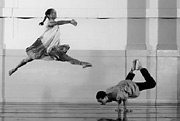SO WHAT DO you do after your choreography for a hit Broadway musical wins you a Tony award, a Drama Desk award, an Outer Critics Circle award, and an Astaire award? You go back to the studio and make more dances for your company—if you’re Garth Fagan, that is. After the runaway success of his work on The Lion King he returned to Rochester, NY, and his company to make Two Pieces of One: Green and Woza, both of which will be on the bill when Garth Fagan Dance performs here this week.
Garth Fagan Dance
April 6-8 at Meany Hall
For all the exposure that his recent experience with The Lion King has given him, Fagan has been making dances for over 30 years, and his company’s repertory reflects that depth of skill as well as his wide-ranging interests in movement and music. His current success just brings a stronger focus on an already powerful combination of styles. He incorporates material from his native Jamaica with influences from his study with artists like Martha Graham, Jos頌im�and Alvin Ailey, creating a movement style that honors the internal motor of his African heritage and the groundbreaking structures of American modern dance. His dances speak to your guts and to your head.
The program for Fagan’s upcoming shows reflects that diversity, with music ranging from 16th-century sacred composer Cristobal de Morales to the ragtime of the Preservation Hall Jazz Band. Somewhere in between the two is John Cage, whose Sixteen Dances for Soloist and Company of Three, originally made for Merce Cunningham, is the score for Fagan’s A Trois.
When he founded his company in 1970, Fagan called it Bottom of the Bucket, But. Most of his dancers were his students at the State University of New York in Rochester, some just stepping into the professional world. Working with that early group, he frequently made a virtue of necessity, creating a repertory of dances that highlighted their individual qualities rather than asking for a uniform virtuosity. And although his current group of dancers (some of whom were in the original ensemble) have become very good indeed, with several awards among them, the choreography still has flashes of that earlier wobble, rather like a bird finding its legs after it’s emerged from its shell. In A Trois, two dancers carry a third as they lean and tug on each other, making their burden undulate like a wave on the ocean. For a moment we’re not sure if that wavering is deliberate or unintentional, but the rest of the performance is so full of glorious dancing, it must have been planned.
Fagan won’t rule out another Broadway commission (indeed, he’s spending much of his time right now in Toronto preparing a new Lion King production), but in the end he’ll return to concert dance and his company, bringing his shelf of awards with him.








